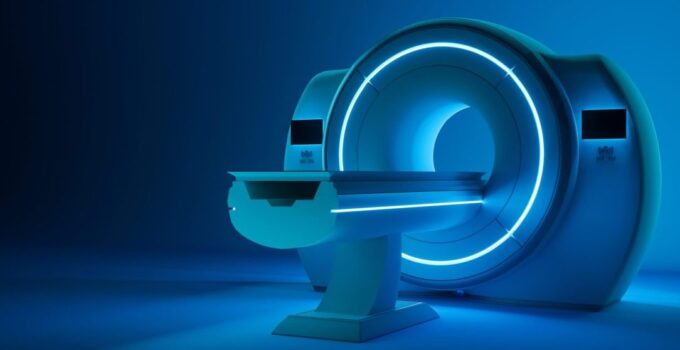Radiology is an evident and mushrooming field in the 21st century. Diagnostic imaging is its second name. In this process, different tests capture images from different body parts. The tests are unlike routine tests as they help doctors gain body insights. Also, besides images, various exams can be used that help to look at the body’s inside organs. These tests are as follows:
- X-rays and MRI that generate reports in a diagrammatic form
- CT scans that help to understand the brain’s condition
- Mammography of the body parts and the body’s condition post the intake of nuclear medicines
- PET scan, and others like fluoroscopy, as well as bone mineral densitometry.
AI And Radiology

Source: openaccessgovernment.org
Thanks to the rise of technology and its developments at a large scale, artificial intelligence (AI) has made its way to medical practice, too. It helps in process refining and streamlines the workflows followed by a professional translation of complexities to efficient purposes and progressive approaches to detect and resolve body diseases.
Artificial Intelligence (AI) is mushrooming in radiology and is becoming a part of the daily-life practice of radiologists across the globe. It renders excellent benefits discussed as follows:
- It helps enhance the degree of efficiency in extracting the correct information from different body parts and also helps in improving diagnostic capacity.
- It possesses the right potential to gather a considerable amount of data by running tests that run for some seconds or minutes.
- Radiologists can prioritize their worklists and diagnoses with AI. It helps in improving their availability to help patients.
Also, if you discuss it as a global industry, it is worth $250 billion. The ongoing seismic changes will help the industry and transform how solutions and services are sought by the patients and provided by expert radiologists across the globe.
However, you might not be on the right page if you think that AI developments will replace radiologists. Here are some points that will help you second this approach.
- It helps simplify the processes and streamlines the overall functioning to reshape the world of radiology.
- The unforeseen healthcare challenges like the coronavirus outbreak in 2020 seek the assistance of AI. It dwells along with this particular healthcare service and helps in clearing the existing backlog in the cases that could not be catered to during the outbreak.
- It helps develop a proactive approach that helps the AI develop at a large scale.
Importance Of Radiology

Source: siemens-healthineers.com
The requirement of radiologists is regular. The tasks they are equipped to do are much more than what technology offers in the present scenario. Be it the patient-facing work or consultancy with physicians for multi-disciplinary works, followed by training and audits, and there is a lot that this industry and its experts like w-radiology.com have to offer.
Radiology extends advanced tools and techniques that are a benefit for patients. The diagnostic pictures give the correct details and help the doctors gather better information about the body changes or the structural variation. Also, multiple options enhance the disease treatment as they help in easy detection and simplifying processes.
Late diagnosis is one of the major concerns of the healthcare industry, and radiology is essential as the tests can help in early diagnosis followed by a better rate to cure the health concerns.
Imagine a world without radiologists and their services. What would it be like?
How would you know if you have a severe migraine attack on the head and at the back of the neck? Running a CT scan will help your doctor to check the degree of severity of the issue and recommend treatment accordingly.
No matter how little any bodily pain is, the treatment will become long and problematic until it is guided by proper images and insights that are helpful with radiology. Also, this is an elaborated field as it is segmented into various types as follows:
● Diagnostic Radiology
It is helpful in correctly diagnosing the disease, followed by the proper treatment. The processes that are used are as follows:
- Ultrasounds and electromagnetic radiation
- X-rays to know different body parts.
● Interventional Radiology
It is helpful in conditions other than cancerous ones. It is related to a medical imaging process. The process is safe and helps a patient to recover fast. The process is of great help in surgical processes. The principle behind it is keyhole surgery. In this surgery, the surgeon makes minor cuts with the help of tiny cameras inside the patient’s affected body part.
● Radiation Oncology
Radiations are a high-energy category as it helps in treating the cancer cells, damage them, and prevent them from spreading in the body. It is common amongst cancer patients. Anyone who is pursuing radiology often correlates it with cancer. However, radiation oncology is the one that helps the patients in their treatment.

Source: .nzherald.co.nz
Future Of Radiology
Radiology adds excellent value to healthcare and is here to stay. So, to clarify, Artificial Intelligence has no plans to replace radiologists in the future. Instead, radiology can extract its enhanced functioning and efficiency from various aspects of AI.
- Radiologists are in a better place to interpret the images and render necessary information to the doctors rendering the treatment.
- If there is an advancement in healthcare issues, they help to add to the screening value, followed by staging and treatment options.
- They will monitor treatment with various kinds of imaging and methods of treatment and disease diagnosis.
- Also, they help in spreading awareness and information regarding disease detection.
The professionals are committed to rendering qualitative improvement, which adds to a greater degree of optimism in healthcare.
Conclusion
Hence, as the medical field progresses and uncertainty prevails, radiology in healthcare has a vast scope. So, regardless if you want to pursue this field as your career or want to discuss this as a concerned individual about the future of healthcare, radiology has an elaborated role to play in strengthening the healthcare industry.





